
Marcellus is awesome.
Shakespeare nerd and Senior Staffer Abby Rubel couldn’t resist checking out KCST’s spring production of Hamlet.
Editor’s note, 4/28 2:15 pm: One line in the review about Hamlet and Horatio’s relationship and the caption of the photo depicting these two characters have been changed; this line and caption utilized a homophobic trope.
Anyone who knows any line of Shakespeare knows at least part of Hamlet’s famous soliloquy: “To be, or not to be, that is the question,” goes the speech. As powerful as it is written on the page, it’s somehow even more compelling delivered on the steps of Earl Hall, with Hamlet, played by Bailey Coleman (BC ’19), lit dramatically from below.
Every year, the King’s Crown Shakespeare Troupe puts on a production of Shakespeare using Columbia’s campus as the set. Ensemble members lead the audience from location to location. This year’s show, Hamlet, is much more well-known that last year’s As You Like It, and there’s baggage that comes with that. After all, how could you possibly deliver the same lines as Kenneth Branagh?
Hamlet is the story of a prince of Denmark whose uncle, Claudius, kills his father and marries his mother. Hamlet’s father’s ghost appears to him and asks that Hamlet revenge him. Hamlet agrees. What follows is, of course, a tragedy. Hamlet pretends to be mad and kills Polonius (the king’s advisor), which drives Ophelia (his lady-love) insane. In revenge, Ophelia’s brother, Laertes, conspires with Claudius to kill Hamlet in a fencing match. As backup, Claudius poisons a glass of wine. Unsurprisingly, the whole scheme goes wrong and everyone dies except Horatio, Hamlet’s best friend. But you already knew that.
KCST’s production was truly moving. A production of Hamlet without a good Hamlet is sunk, but Coleman bore her burden well, giving a phenomenal performance. She spat her lines at an unbelievably fast pace but enunciated so well that every word was clear. Her physicality and the emphasis she gave to certain words helped make the ideas at the heart of the show clear. Coleman managed to encompass both the tragedy and ridiculousness of Hamlet into one spectacular performance. She had great chemistry with all the other actors, particularly Oona Mackinnon-Hoban (BC ’21), who played Horatio as an uptight dork quite well. In the final moments of the play, these character were especially moving. I cried.
Gabrielle Bullard, BC ’18, also gave an excellent performance as Ophelia, although she didn’t truly come into her own until Ophelia’s scenes of madness. Those scenes are easy to overplay and tilt into ridiculousness, but Bullard was mostly restrained, which made her moments of shrieking even more impactful. Alexander Keefe, CC ’20, didn’t settle into his character of Polonius until about halfway through the play, but died particularly well. It was somewhat over the top, but given that his dying line is “I am slain,” Keefe managed to retain some pathos. Alex Peile was a charming Marcellus, and I wished he had had more stage time. Stacy Grinberg (CC ’18) livened up the end of the play with her flamboyant portrayal of Osric, particularly her exaggerated French accent. Although not always noticeable, the ensemble enhanced crucial moments in the play, especially by singing during Ophelia’s madness. They were also effective at shepherding the audience around campus, keeping the mood of the play going while also giving clear directions.
The costumes, by Perry Levitch (BC ’19) and Catherine Ferrante (CC ’21), were mostly Western business attire. The palette was kept mostly gray and black except for the red worn by Gertrude and Claudius, the lighter colors worn by Ophelia, and Osric’s fabulous gold suit. The color scheme helped the audience gauge the characters’ emotional states at a glance. The ghost’s costume was particularly effective, reflecting the aesthetic of the play while being sufficiently creepy. The makeup design created by Dara Diamond (BC ’19) and Sandy Gooen (BC ’18) was especially notable for their use of eyeliner. Hamlet had angsty emo eyeliner which made Coleman look more threatening in her erratic moments, and the King Hamlet’s ghost’s (Jared Rush, CC ‘21) eyeliner was smeared under his eyes, creating a parallel between father and son.
Given that the play takes outside and is difficult to light, Liz Schweitzer (BC ’18) did an excellent job, particularly lighting the ghost with ghastly green lighting. The scene where the ghost appears to Hamlet and Gertrude created a clear divide between the greenish world of the dead and the yellow world of the living.
The production used campus to great effect. At times, it felt as if one was watching something that had taken place on Columbia’s campus many years ago, as if the actors were ghosts recreating the events of the play. There were moments when my legs fell asleep from sitting on the hard ground, and my companion complained about the amount of movement involved, but overall it was worth it to see the final scene performed in the tent outside Schermerhorn, which made it feel like an actual fencing match rather than a performance.
Hamlet will be performed tonight at 11:59 pm (the drunk show!) and tomorrow at 8 pm. Tickets are free and the play starts on Low Steps.
- Marcellus is so cool this photo is going in twice.
- Father and son.
- Claudius, Gertrude, and Polonius.
- Ophelia and Hamlet. Look at that manspreading!
- Osric in his amazing suit.
- Hamlet and Horatio.
Photos courtesy of Sukanya Janardhanan


 1 Comments
1 Comments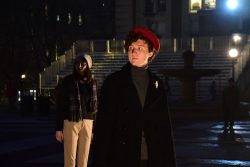
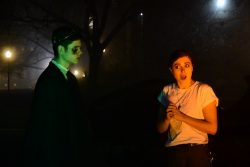
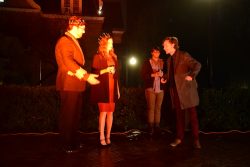
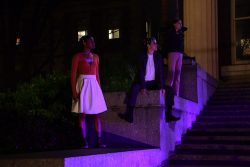
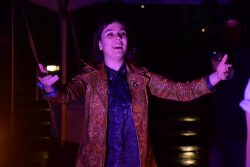
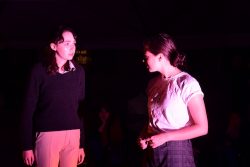

1 Comment
@Anonymous got super drunk and thought it was macbeth the entire time but it was the best play I’ve seen in my life!!